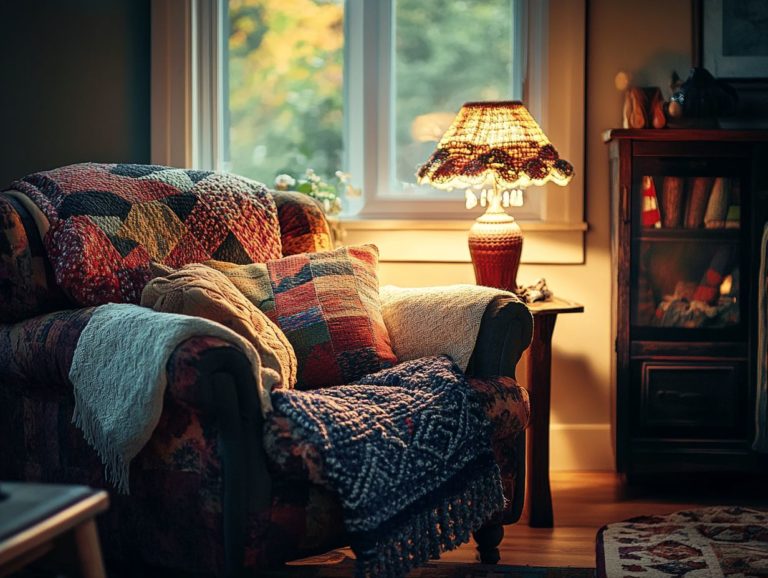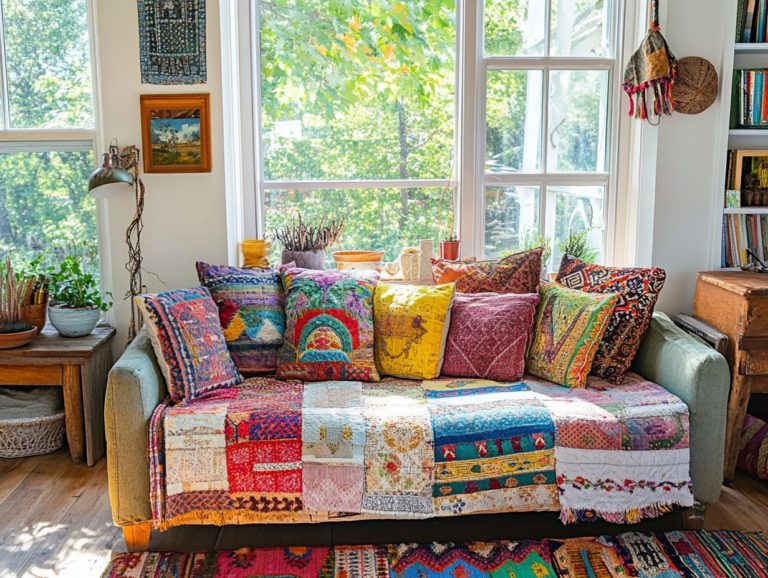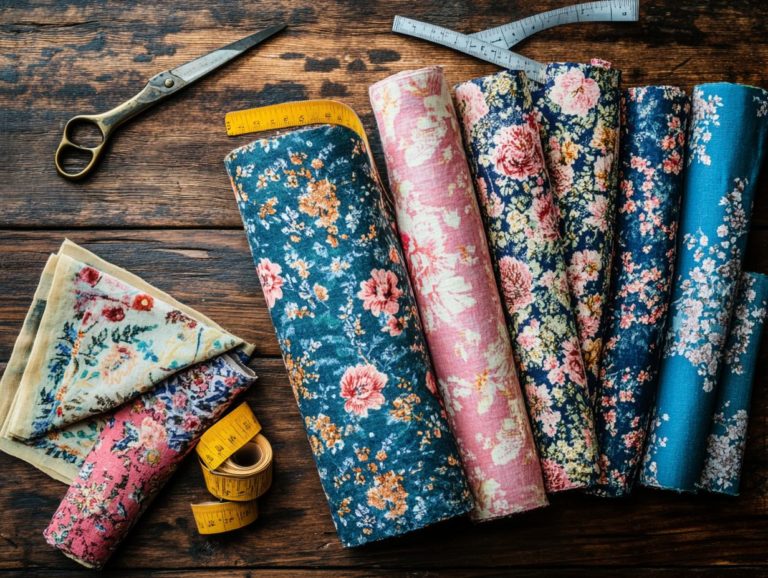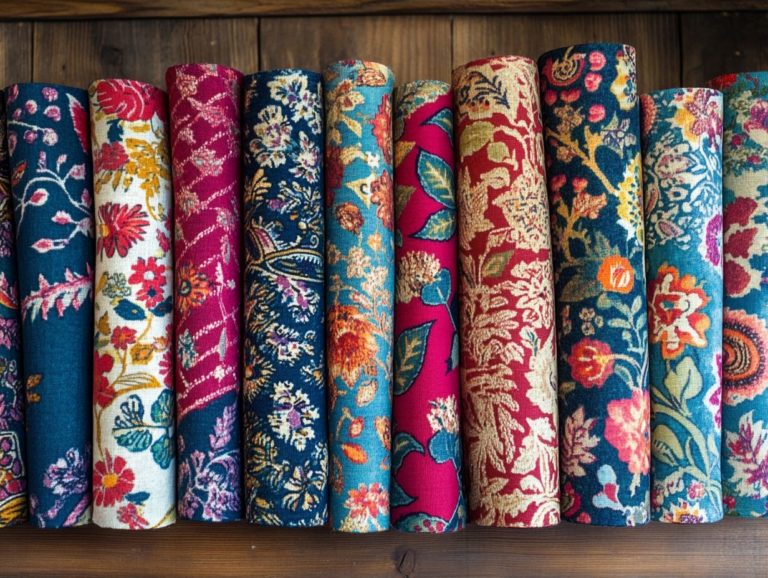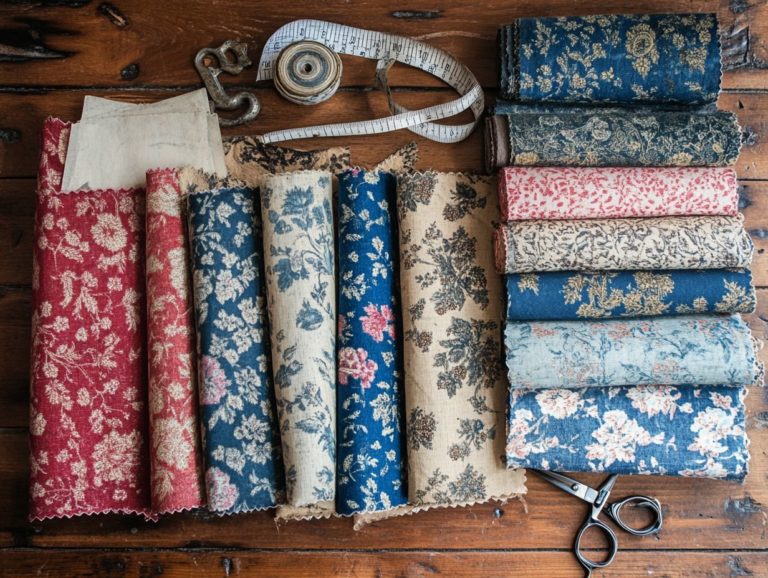Common Mistakes When Working with Vintage Fabrics
When it comes to vintage fabrics, their charm and uniqueness can be both a delight and a challenge for you.
Whether you re a seasoned crafter or just embarking on your creative journey, it s essential to grasp the common pitfalls that can arise when working with these delicate materials.
This article delves into frequent mistakes, such as neglecting the fabric’s history, using improper cleaning techniques, and overlooking their fragility.
You ll find valuable tips to care for vintage fabrics and use them creatively, ensuring your projects radiate with timeless elegance.
Contents
- Key Takeaways:
- Common Mistakes When Working with Vintage Fabrics
- Tips for Working with Vintage Fabrics
- Frequently Asked Questions
- What are some common mistakes when working with vintage fabrics?
- Can I use modern sewing techniques when working with vintage fabrics?
- How should I handle delicate vintage fabrics?
- What should I consider when working with vintage fabrics?
- How can I avoid damaging vintage fabrics while sewing?
- Is it necessary to pre-wash vintage fabrics before sewing?
Key Takeaways:
- Not knowing a vintage fabric’s history can lead to improper care and potential damage.
- Properly cleaning and storing vintage fabrics is crucial to preserving their quality and longevity.
- Using gentle techniques and tools is essential when working with fragile vintage fabrics to avoid damage.
Defining Vintage Fabrics
Vintage fabrics are not just textiles; they are pieces of history that showcase unique characteristics and patterns reflective of their eras.
Often discovered in estate sales, these treasures range from vintage quilts and linens to charming handkerchief dresses. Each piece deserves your careful attention in terms of both fabric care and preservation.
By understanding the various types of fabrics, their histories, and their natural beauty, you enhance your fabric knowledge. This ensures that each piece is treated with the respect it warrants for future generations.
Within the extensive world of vintage fabrics, you might encounter intricate brocades (a fabric with a raised design) from the Victorian era, delicate cottons from the 1940s, and whimsical prints from the 1960s.
Each fabric tells a story woven from the social and cultural influences of its time. For example, the bold patterns of mid-century fabrics can evoke the lively spirit of a post-war society, while art deco textiles whisper tales of the glamour and elegance characteristic of the Roaring Twenties.
To keep these beautiful pieces alive, you need to learn some special cleaning tricks!
Preserving these pieces requires an understanding of specialized cleaning techniques necessary to maintain their integrity. Fabric care tips, such as gentle hand washing and steering clear of harsh chemicals, are crucial in prolonging the lifespan of these cherished textiles.
By valuing their past and employing meticulous care, you contribute to ongoing textile preservation efforts while enjoying their aesthetic qualities for years to come.
Common Mistakes When Working with Vintage Fabrics
When you work with vintage fabrics, it s easy to fall into common pitfalls that might compromise the integrity and beauty of your cherished finds.
Mistakes such as neglecting proper fabric maintenance or disregarding specific cleaning guidelines can result in irreversible damage to items like vintage quilts or linens.
By recognizing the significance of appropriate cleaning methods and steering clear of common sewing errors, you can preserve these unique fabric treasures for years to come.
Not Knowing the Fabric’s History
One of the biggest pitfalls you might encounter when working with vintage fabrics is a lack of knowledge about the fabric’s history. This can significantly influence how it should be cared for and maintained.
Each piece be it a vintage quilt or a handkerchief dress carries its own stories from the past. Understanding these narratives allows you to adopt better preservation practices.
Without this background, you could unintentionally opt for cleaning methods or storage techniques that might jeopardize your vintage treasures.
To truly appreciate these textiles, consider the era and materials that shaped their creation. For example, delicate silk demands gentle washing methods, often using cold water and mild detergents. More robust cotton can handle sturdier cleaning processes.
Conducting thorough research whether by consulting textile history books, exploring online archives, or reaching out to vintage fabric experts can provide you with invaluable insights.
Knowing the specific origins and any past repairs can guide you in maintaining the fabric’s integrity. This ultimately ensures that these unique pieces remain beautiful for generations to come.
Not Properly Cleaning and Storing Vintage Fabrics

Improper cleaning and storage of vintage fabrics can result in irreversible damage. It’s essential to master the right storage tips and cleaning guidelines as a discerning fabric collector.
Treasure your vintage fabrics with the loving care they deserve! Basic cleaning methods, such as a white vinegar bath, can be quite effective for certain fabric types. For more in-depth guidance, consider exploring the best vintage fabric restoration techniques. Failing to adhere to these practices can lead to fabric stains, deterioration, or a loss of shape and strength.
To preserve the beauty and longevity of these delicate items, you should regularly air out the fabric, allowing it to breathe and dispel any odors that may have developed over time. Gentle washing is also recommended, using mild detergents specifically formulated for delicate materials.
Regarding storage, opt for acid-free tissue paper to wrap your fabrics, as it provides protection against light and dust. Proper storage in a cool, dry place is crucial to prevent moisture buildup that could lead to mold or mildew. This ensures that these vintage pieces remain in pristine condition for future generations to admire.
Not Considering the Fabric’s Fragility
A major oversight when working with vintage fabrics is the tendency to overlook their fragility. This can lead to damaging choices during cleaning and storage. Recognizing the delicate nature of certain vintage textiles like silk or hand-stitched quilts is essential for their preservation and for ensuring that the right cleaning methods are applied.
This knowledge enables you to take appropriate measures. Seeking advice from a fabric expert can help determine the best way to care for delicate pieces.
Understanding fabric characteristics is vital; each type may require specific maintenance approaches to prevent irreversible damage. For example, cleaning silk calls for gentle techniques, often involving dry cleaning or hand washing with cold water and mild detergents.
Similarly, vintage lace and embroidered fabrics demand the same level of delicacy, as rough handling can easily result in tearing or fraying. Ultimately, immersing yourself in the world of vintage textiles means prioritizing a thorough understanding of fabric fragility. For those interested in preserving these treasures, learning how to care for vintage textiles and fabrics will help you maintain their beauty and extend their lifespan.
Not Using the Right Techniques and Tools
Failing to employ the right techniques and tools when handling vintage fabrics can lead to unintended damage. It s essential for you to grasp the appropriate cleaning methods and care tips tailored to each fabric type.
Whether you re gently washing delicate materials or steering clear of strong fabric softeners that could erode the fibers, knowing the right approach is crucial for preserving these treasures. Utilizing suitable sewing techniques can help you avoid mistakes that might compromise the integrity of vintage textiles.
To effectively maintain these cherished pieces, consider exploring various fabric cleaning methods, such as:
- Spot cleaning with mild soap and water
- Opting for professional dry cleaning services when necessary
Always test any cleaning solution on a less conspicuous area first to avoid unwelcome surprises. When sewing, selecting the correct needle type and thread can significantly enhance your results. Additionally, refer to this guide on working with delicate vintage fabrics for more tips.
Incorporating fabric care strategies like storing items in breathable bags and keeping them away from direct sunlight will further safeguard these fabrics. By following these guidelines, you ensure that vintage textiles remain beautiful and intact for future generations to appreciate.
Tips for Working with Vintage Fabrics
When you engage with vintage fabrics, applying thoughtful care techniques can greatly enhance the longevity and beauty of each piece.
By appreciating the fabric’s history and employing specialized cleaning methods such as a gentle white vinegar bath or allowing the fabric to air out you can ensure that your vintage treasures remain in impeccable condition.
Furthermore, seek expert sewing advice specifically designed for vintage textiles. This will help you avoid common pitfalls and contribute significantly to their preservation, such as learning how to repair vintage fabrics at home.
Researching the Fabric’s History
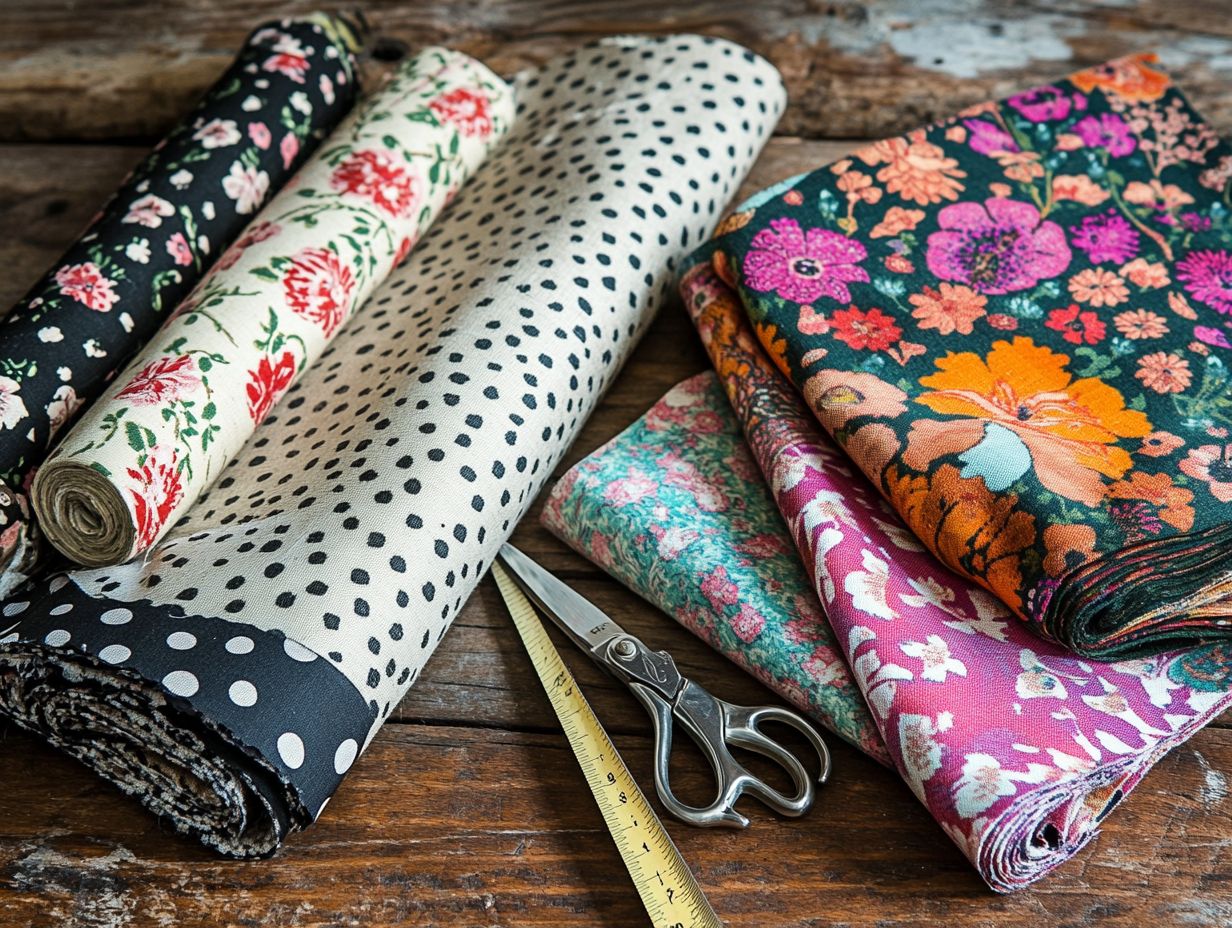
Researching the fabric s history is essential for caring for your vintage textiles. Knowing the origins, uses, and specific care requirements enhances your experience as a collector.
You can use various resources to explore the history of fabrics. Online databases provide a treasure trove of information about vintage textiles, including popular fabric characteristics and their historical significance.
Engaging with textile history experts can deepen your understanding. They offer tailored guidance that highlights the unique care needs of different fabric types.
As you tap into these resources, you cultivate a deeper grasp of your vintage collection and the stories woven into each fabric.
Proper Cleaning and Storage Methods
Keep your vintage fabrics in great shape with proper cleaning and storage methods. Techniques like gentle washing and avoiding fabric softeners can enhance the care of your vintage treasures.
To achieve optimal fabric preservation, select cleaning agents and methods suited to each fabric type. For instance, delicate fabrics like silk or lace often require hand washing in cool water with mild detergents. Sturdier materials can usually withstand machine washing on a gentle cycle.
After washing, consider gentle drying methods like laying flat or air drying to protect the fibers. For storage, use acid-free materials and keep your garments in a cool, dark space to protect against discoloration, mold, and pests.
By following these careful cleaning and storage practices, you ensure that the beauty and history of your vintage fabrics are preserved for future generations to appreciate.
Using Gentle Techniques and Tools
Using gentle techniques and tools when working with vintage fabrics can greatly enhance their preservation. Methods such as gentle washing and avoiding harsh detergents or fabric softeners are essential for maintaining the integrity of each piece.
For example, hand washing with a mild, pH-balanced soap is a great way to clean delicate materials without causing harm. Air drying in the shade helps keep colors vibrant and prevents fading.
When tackling stains, a soft bristle brush can be your best ally, working wonders without compromising the fabric s fibers. Vintage beauty deserves to shine; tools like silk and wool brushes help gently remove dust and dirt.
Regular inspections are equally important. Addressing small tears or frayed seams promptly ensures your vintage fabrics remain enchanting heirlooms for generations.
Frequently Asked Questions
What are some common mistakes when working with vintage fabrics?
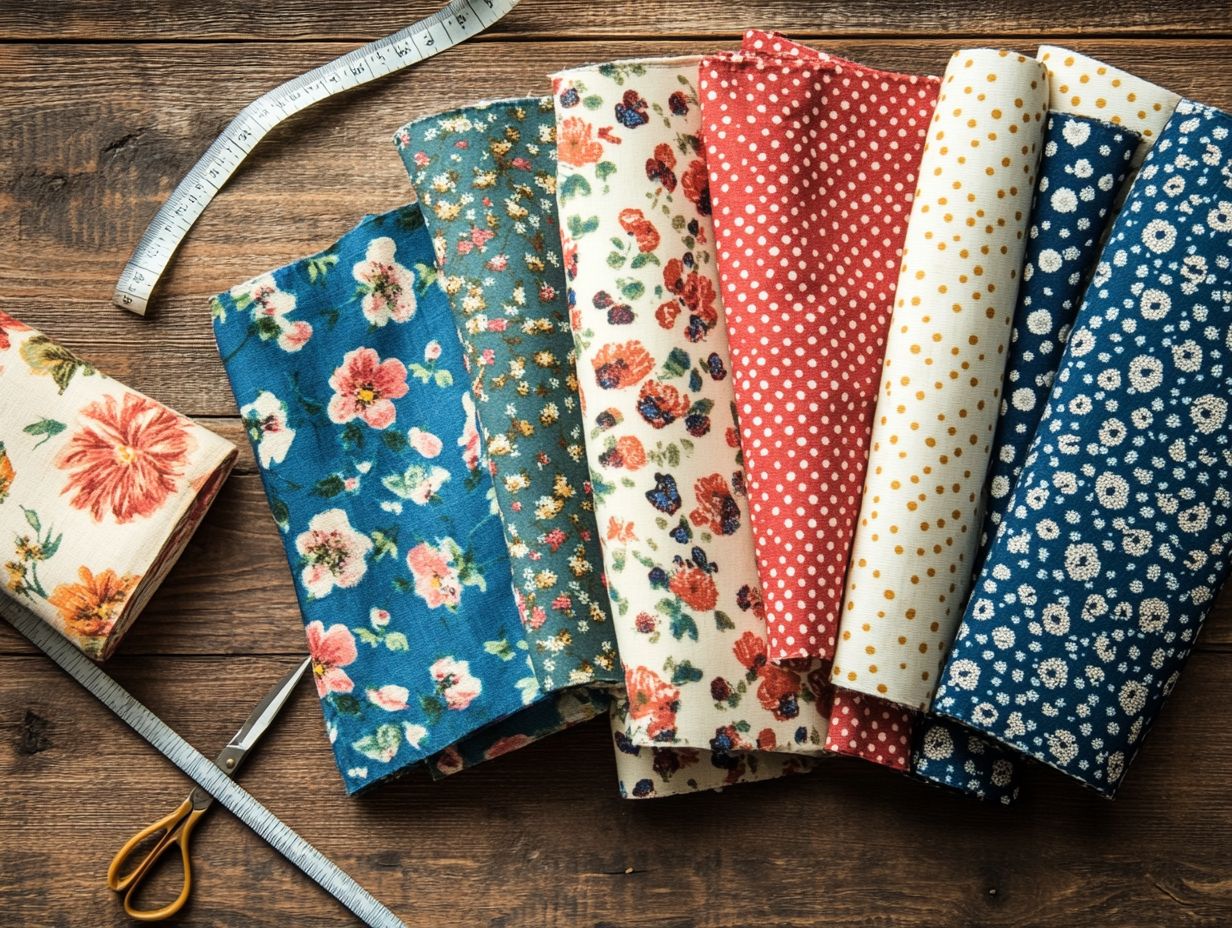
Common mistakes include using modern techniques and mishandling delicate fabrics. Always remember the age and fragility of your vintage textiles.
Can I use modern sewing techniques when working with vintage fabrics?
While it may seem easier to use modern sewing techniques, remember that vintage fabrics were made with different methods. They often require special techniques to work with them properly.
How should I handle delicate vintage fabrics?
Handle delicate vintage fabrics with extreme care. Use clean hands and work on a spotless surface.
What should I consider when working with vintage fabrics?
Consider the age and fragility of vintage fabrics. This affects how to handle, sew, and store them.
How can I avoid damaging vintage fabrics while sewing?
To protect vintage fabrics while sewing, use sharp, clean needles. Sew slowly and choose the right thread and sewing methods.
Is it necessary to pre-wash vintage fabrics before sewing?
Pre-washing vintage fabrics is a smart move! It removes dirt and odors and helps you check for shrinkage. Always research the specific fabric’s care instructions first.

